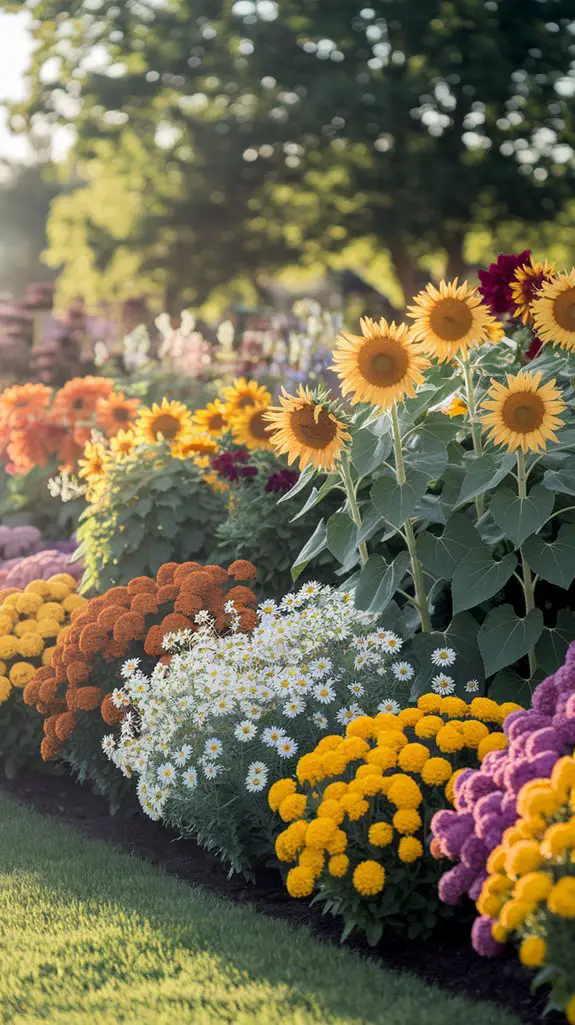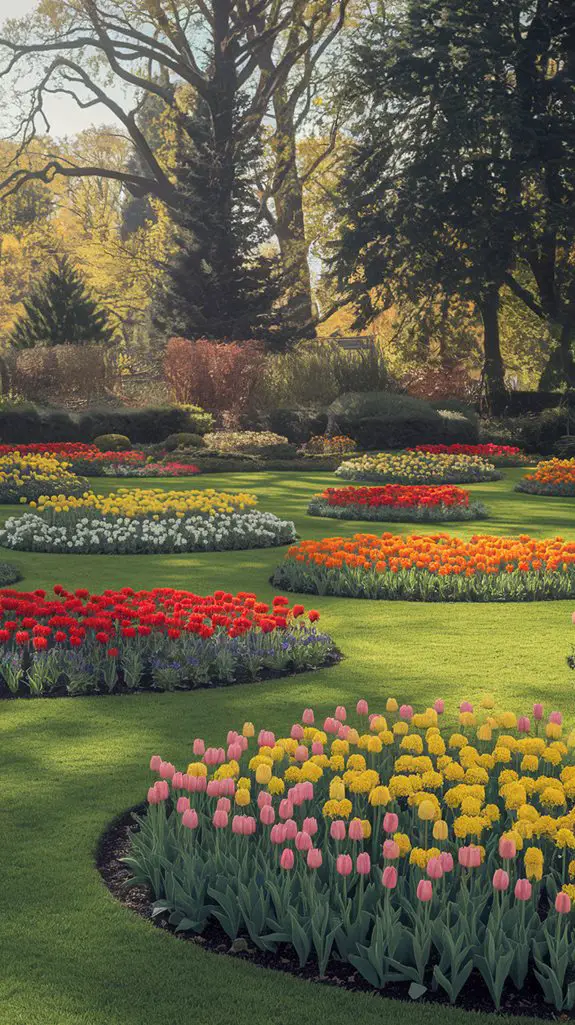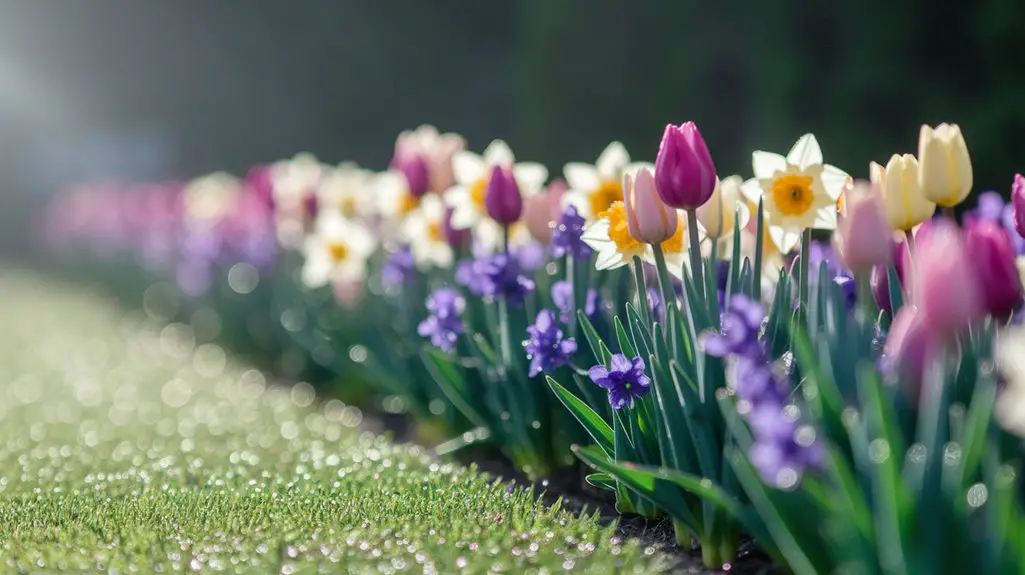Imagine a lawn so vibrant with blooms that your neighbors will mistake it for a professional botanical display. You’ll need more than basic gardening skills to achieve this seasonal spectacle. The secret lies in understanding the intricate relationships between soil biology, plant selection, and strategic placement techniques. When you’ve mastered the science of bloom cycles and companion planting, your lawn will transform into a living canvas of color that evolves precisely as you’ve designed it to—season after season.
Assessing Your Soil Quality and Ph Balance
Before starting on any seasonal planting endeavor, you’ll need to conduct a thorough soil assessment to determine its quality and pH balance.
Purchase a soil testing kit from your local garden center to measure pH levels (ideally between 6.0-7.0 for most flowering plants). Identify your soil type—sandy, clay, loam, or silt—as each requires different amendments.
For acidic soils (pH < 6.0), incorporate limestone to raise pH. For alkaline soils (pH > 7.0), add sulfur or peat moss to lower pH.
Test for essential macronutrients: nitrogen (N), phosphorus (P), and potassium (K). Nitrogen promotes foliage growth, phosphorus enhances root development and flowering, while potassium improves overall plant health and disease resistance. Additionally, eco-friendly practices such as composting can enhance soil quality and nutrient content.
Document your findings methodically, creating a soil amendment strategy based on deficiencies identified.
Retest annually to track improvements.
Selecting the Right Flower Varieties for Your Climate Zone

With properly balanced soil as your foundation, the next determinant of flowering success lies in selecting botanically appropriate varieties for your specific climate zone.
Identify your USDA hardiness zone (ranging from 1-13) to narrow suitable plant options based on temperature tolerance thresholds.
For zones 2-5, prioritize cold-hardy perennials like Echinacea, Rudbeckia, and Phlox.
In zones 6-8, you’ll succeed with Coreopsis, Salvia, and ornamental grasses.
Zones 9-13 support heat-tolerant specimens including Lantana, Plumbago, and desert-adapted succulents.
Beyond zone compatibility, assess your microclimate’s specific conditions: sun exposure, wind patterns, and precipitation rates.
Match these parameters with each species’ cultural requirements.
Select native species when possible, as they’ve evolved ideal adaptations to regional conditions and typically demand fewer resources for sustained vigor.
Strategic Planting Techniques for Year-Round Color

Achieving continuous garden interest throughout the seasons requires deliberate planning of bloom sequences rather than spontaneous plant selection.
You’ll need to implement succession planting, positioning early spring bulbs (Galanthus, Crocus) beneath later-emerging perennials to maximize spatial efficiency.
Layer your plantings vertically: ground covers, mid-height perennials, and structural specimens. Incorporate plants with staggered bloom periods—early (Hellebores), mid-season (Echinacea), and late (Asters)—in each garden section.
You’ll achieve ideal visual impact by clustering identical specimens in groups of three to seven rather than distributing them individually.
Track bloom times meticulously in your garden journal, identifying temporal gaps for future correction. Consider foliage color and texture as secondary design elements to maintain visual interest during flowering shifts.
Design with microclimates in mind to extend blooming periods beyond typical calendars. Additionally, consider incorporating perennial vegetables into your garden design, as they can provide both beauty and utility throughout the growing season.
Proper Watering and Irrigation Systems for Flowering Lawns
Establishing ideal moisture levels constitutes the foundation of sustainable flowering lawn cultivation.
You’ll need to implement a precise watering schedule that accommodates both soil composition and specific bloom requirements. For clay soils, deliver 1″ of water weekly in fewer sessions; sandy soils require the same volume but at higher frequency.
Install drip irrigation systems to minimize evaporation and target root zones effectively. Position emitters 4-6″ from plant bases for optimal hydration without crown saturation.
Incorporate soil moisture sensors calibrated at 2″ and 6″ depths to monitor hydration accurately across varying root structures.
During flowering periods, adjust irrigation timing to early morning (5-7 AM) to reduce fungal development while maximizing absorption efficiency.
Implement seasonal adjustments—reducing frequency by 30% during dormancy periods and increasing by 15-20% during peak blooming phases.
Natural Fertilization Methods for Healthier Blooms
Proper irrigation supports plant vigor, but nutrition serves as the biochemical foundation for spectacular blooms. You’ll achieve ideal flowering by implementing strategic organic fertilization protocols that enhance soil biology rather than merely adding nutrients.
| Fertilizer Type | Application Timing | Primary Benefits |
|---|---|---|
| Compost Tea | Early spring | Microbiome enhancement |
| Bone Meal | Pre-flowering | Phosphorus for bud development |
| Fish Emulsion | Monthly during growth | Balanced NPK with micronutrients |
Integrate these natural amendments by applying when soil temperature exceeds 55°F. Your flowering species will respond with enhanced pigmentation and structural integrity when you maintain soil pH between 6.2-6.8 for most ornamentals. Track application rates meticulously—excessive nitrogen promotes foliage at the expense of bloom expression. Mycorrhizal inoculants establish vital symbiotic relationships that improve nutrient uptake efficiency by 30-45%. Additionally, using eco-friendly practices can contribute to a healthier lawn ecosystem and more vibrant blooms.
Managing Pests and Diseases in Flowering Lawn Areas
While vibrant blooms attract beneficial pollinators, they simultaneously invite destructive pests that can compromise flowering performance and aesthetic quality.
Monitor your flowering areas weekly for aphids, thrips, and spider mites, which typically cluster on stem joints and leaf undersides.
Implement integrated pest management (IPM) by introducing predatory insects like ladybugs and lacewings before applying botanical insecticides such as neem oil or pyrethrin.
For fungal infections—powdery mildew, rust, and botrytis—improve air circulation by proper spacing and selective pruning.
You’ll need to remove infected plant material immediately and avoid overhead watering, which creates favorable conditions for pathogen development.
Apply copper-based fungicides only when cultural controls fail.
Remember that prevention through proper sanitation and resistant cultivar selection remains more effective than reactive treatment. Additionally, natural pest control methods can significantly enhance the health and resilience of your flowering plants.
Seasonal Maintenance Schedules for Maximum Vibrancy
Beyond pest control measures, the implementation of precise, seasonally-calibrated maintenance routines will remarkably amplify your flowering lawn’s vibrancy and longevity.
You’ll need to synchronize your activities with your region’s phenological calendar—spring necessitates soil aeration, pH adjustment (5.5-7.0 ideal), and initial fertilization (N-P-K ratio 5-10-5).
Summer demands strategic irrigation protocols—hydrate at 25mm weekly during pre-dawn hours (4:00-6:00 AM) to minimize evaporation.
Apply selective deadheading to prolific bloomers while maintaining cutting heights at 7.5-10cm.
For autumn, reduce nitrogen inputs, increase potassium (3-5-12 ratio), and incorporate fallen organic matter through light raking.
Winter requires minimal intervention—apply protective mulch (2.5cm depth) to crown-sensitive species and remove accumulated debris that may harbor pathogenic fungi. Additionally, regular vegetable garden maintenance can enhance the overall health of your lawn ecosystem.
Creating Complementary Bloom Patterns With Different Species
When designing complementary bloom patterns, strategic species selection becomes the foundational element for creating visual rhythm and functional biodiversity throughout your growing season.
Layer early bloomers like crocus and snowdrops (Zones 3-8) beneath mid-season performers such as Allium and Echinacea (Zones 4-9). Incorporate late-season specialists including asters and Japanese anemones (Zones 4-8) to maintain continuous color succession.
You’ll need to calculate bloom duration overlaps—aim for 2-3 week shifts between dominant flowering periods.
For ideal pollinator support, pair species with complementary nectar production cycles. Select plants with contrasting heights (10-36″), creating visual planes that draw the eye through the landscape.
Don’t overlook foliage texture—combine fine-textured plants (Coreopsis) with broad-leaved specimens (Hosta) to enhance visual interest even between bloom cycles. Additionally, consider utilizing colorful flower garden landscaping tips to maximize the overall aesthetic appeal of your design.
Conclusion
Envision your lawn as a living canvas, where each bloom functions as a precise brushstroke in nature’s masterpiece. You’ll achieve ideal vibrancy by maintaining soil pH at 6.0-7.0, implementing stratified planting matrices, and adhering to species-specific hydration protocols. It’s the meticulous synchronization of these technical elements—from proper nutrient cycling to strategic deadheading—that transforms ordinary turf into a dynamic, polychromatic ecosystem sustained throughout multiple phenological phases.




